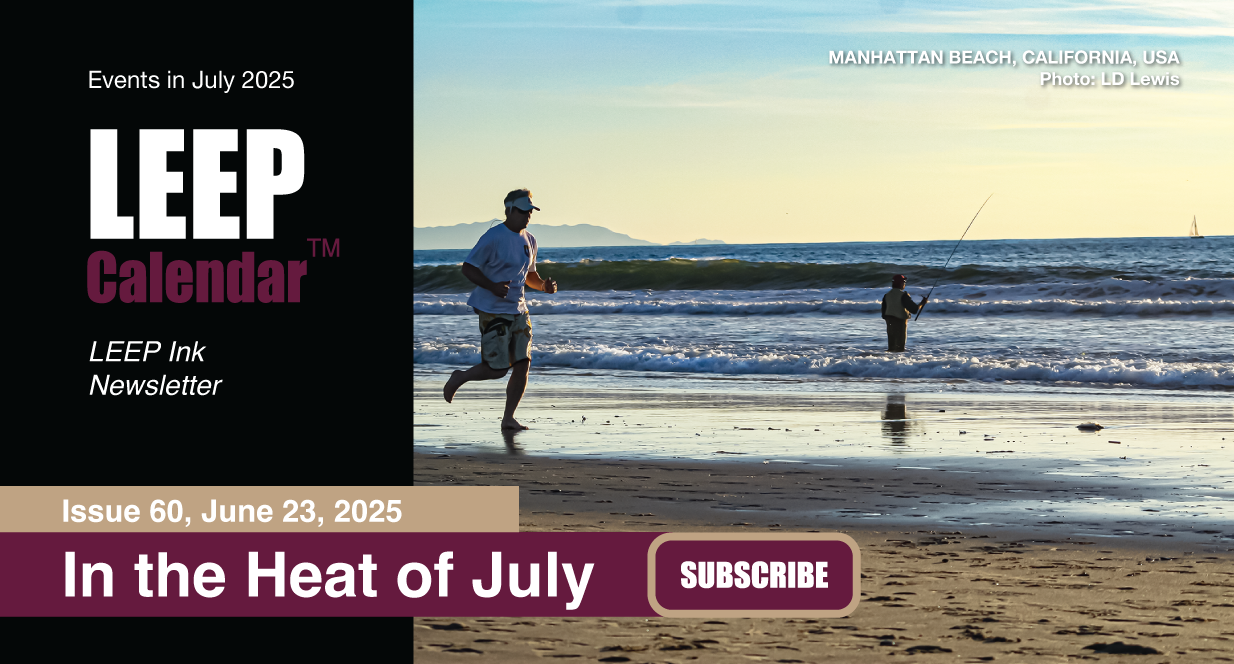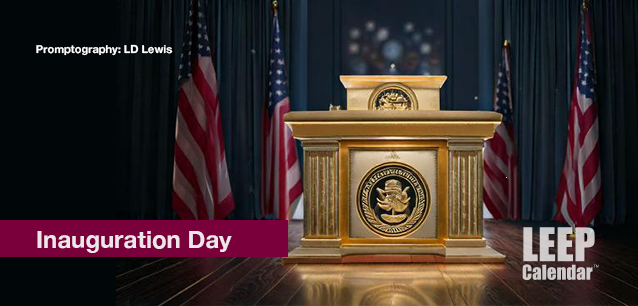 AD
AD
Today is: December 07
Scroll to explore events active on this date.
LEEP INK FEATURES

August? Absolutely!
In August, we live through the Dog Days of Summer. It's hot and often humid, and those who can leave for better climates do. Down south, winter is in full force. August is also known as "the ...

In The Heat of July: July 2025 Events
Is it hot enough (or cold enough if you're below the equator) for you yet? There is actually a day for that! Like every month, I pick a diverse collection of events you may or may not know about. This ...

May Blooms: Events in May 2025
Along with October, May is one of the most densely packed months of the year. It's before the summer humidity and the last whole month of the school year. The weather is warming in t...
About Inauguration Day in the United States
Civil Rights , United States
Ends: Jan 20, 2025
DESCRIPTION:
THE PEACEFUL TRANSFER OF POWER:
INAUGURATION DAY IN THE UNITED STATES
Every four years, on January 20, the United States pauses to celebrate the peaceful transfer of power during Inauguration Day. This centuries-old tradition underscores the strength of the nation's democracy.
However, in the annals of history, the idea of inauguration and the American system of transferring power from leader to leader was novel and unknown.HISTORICAL BACKGROUND
When George Washington took the oath of office in 1789, the notion of a nation's leader peacefully stepping aside and handing over power to a new administration was still considered a grand political experiment. Most 18th-century governments were monarchies led by hereditary rulers who retained their offices for life or faced forced removal.A NEW CONCEPT
America's system of regular elections and orderly inaugurations was unprecedented on a large scale for its time. Historians often cite the United States' early presidential transitions as a significant break from centuries of power passed down through bloodlines or was seized by conquest.
The first inauguration, held in New York City on April 30, 1789, set the stage for this experiment in governance. Though Washington was overwhelmingly popular, his assumption of presidential duties and subsequent peaceful departure after two terms gave the new republic a durable example of how leaders could leave office without military intervention or dynastic claims.EARLY WORLD REACTION
The world watched with a mix of curiosity and skepticism. In the late 18th century, absolute monarchies still held sway in most of Europe, while hereditary rule shaped much of global politics. Many foreign observers doubted that a republic without a monarch could ensure political stability. Newspapers in Europe sometimes ridiculed Americans' "bold" system, and diplomatic envoys wondered how long the United States' constitutional government would hold.
At the same time, a sense of fascination arose among Enlightenment-era thinkers. They saw the American experiment as proof that democratic ideals—espoused by philosophers like John Locke and Montesquieu—could thrive. The orderly nature of the inaugurations and the continuing peaceful transfer of power helped the US gain respect in international circles, even if it sometimes clashed with prevailing norms of hereditary rule.ENDURING PRECEDENT
Over time, the inauguration solidified its status as a cornerstone of the US political system, symbolizing the resilience and adaptability of American democracy. While peaceful power transfers are not unique in the modern era, the regular, institutionalized process that began with Washington remains one of the earliest and most influential examples, inspiring other nations to adopt similar transitions in their constitutions.
AN EVOLVING CUSTOM
The custom of a presidential inauguration began with George Washington's first swearing-in on April 30, 1789, in New York City. For much of the nation's early history, inaugurations took place on March 4—reflecting the slower pace of travel and communication in the 18th and 19th centuries.
That changed with the ratification of the 20th Amendment in 1933, which moved Inauguration Day to January 20. The shift shortened the "lame-duck" period and allowed a newly elected president to begin governing sooner. Franklin D. Roosevelt, entering his second term, became the first president sworn in on January 20, 1937.FORMAT OF THE EVENT
Modern Inauguration Day ceremonies are staged on the West Front of the US Capitol, overlooking the National Mall. At noon, the United States Chief Justice administers the oath of office, fulfilling a constitutional requirement. Moments later, the newly sworn president delivers an inaugural address, often viewed by millions worldwide.
Following the swearing-in and address, the new president and vice president typically attend a congressional luncheon in the Capitol, where congressional leaders from both parties offer brief remarks. A traditional inaugural parade proceeds along Pennsylvania Avenue to the White House in the afternoon. Various local groups, military units and marching bands participate in the festivities.
In the evening, inaugural balls or galas—some official, others unofficial—serve as a celebratory capstone to the day's events. These gatherings allow supporters, dignitaries and the new administration to mark the transition in a more festive setting.MEMORABLE ADDRESSES
Several presidents have delivered inaugural addresses that profoundly shaped the nation's political discourse:
— ABRAHAM LINCOLN'S second inaugural address (1865) is remembered for its conciliatory tone toward the South and its famous line, "With malice toward none; with charity for all," as the Civil War drew to a close.
— FRANKLIN D. ROOSEVELT'S first inaugural (1933) occurred amid the Great Depression. His reassurance that "the only thing we have to fear is fear itself" galvanized public confidence and signaled sweeping New Deal reforms.
— JOHN F. KENNEDY'S 1961 address called on Americans to "ask not what your country can do for you—ask what you can do for your country," capturing the spirit of a new generation eager to meet Cold War challenges.
— RONALD REAGAN, in 1981, emphasized a smaller federal government and championed optimism, reflecting the conservative shift of that era.
— BARACK OBAMA'S 2009 address, the first by an African American president, highlighted hope, unity and perseverance amid economic upheaval and wartime challenges.LARGEST INAUGURAL CROWD
Barack Obama's first inauguration in 2009 drew what is widely regarded as the largest crowd ever to witness a US presidential swearing-in. Estimates put attendance at around 1.8 million people, packing the National Mall from the steps of the Capitol to the Lincoln Memorial.SHORTEST PRESIDENCY
William Henry Harrison holds the sorrowful record of the nation's shortest presidency. Sworn in on March 4, 1841, Harrison delivered a lengthy inaugural address in frigid weather. He fell ill soon after and died just 31 days into his term, on April 4, 1841.CONCLUSION
Today, the pomp and ceremony of Inauguration Day remain a point of national pride and reflection, underscoring the changing priorities of each new administration and the enduring principles enshrined in the Constitution.
The United States government runs on three groups of equal power: the Executive Branch, which includes the president; the Judicial Branch with the Supreme Court; and the Congress, featuring the House of Representatives and the Senate. It is important to note that regardless of the assertions of a president sworn in, a president's executive orders cannot undo a law or a Supreme Court ruling. These executive orders cannot change the Constitution. If an inaugurated president attempts to do any of these actions, that person is foregoing democracy and claiming the mantle of a dictator. It is the job of the Congress and Supreme Court to hold that person in check.
VIDEOS
SUPPORTING DOCUMENTS
Currently, this event does not have supporting documents.
ADDITIONAL IMAGES
Currently, this event does not have supporting images.
Where would you like to go now?
 AD
AD


/footer-logo.svg)
